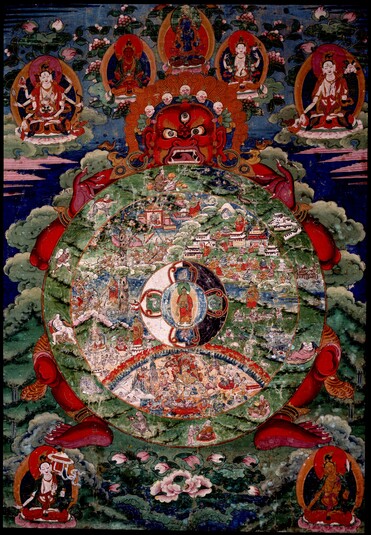
Item: Wheel of Life
| Origin Location | Tibet |
|---|---|
| Date Range | 1800 - 1899 |
| Size | 84.48x56.82cm (33.26x22.37in) |
| Material | Ground Mineral Pigment on Cotton |
| Collection | The Brooklyn Museum of Art |
| Catalogue # | acc. #BMA L25.5, Lent by Frank L. Babbott, Jr. |
Classification: Object/Concept
The Wheel of Life (Tibetan: sid pa’i kor lo. Sanskrit: bhavanachakra).
The Twelve Links begin at the 11:00 position with a blind man walking with a stick.
Held in the tight grasp of Samsara personified (cyclic existence) seen as a fierce wrathful figure, red in colour, with one face and two hands, the circular disc is pressed up against the mouth ready to be swallowed at any moment - the immediacy of impermanence. This wrathful figure is sometimes referred to as Yama, the Lord of Death, and at other times as the red female daemon of death, possibly Yami, the sister of Yama.
First: The inner most of the 4 concentric circles shows a black pig (ignorance), green snake (anger) and a rooster (desire) circling on a blue background. They are often shown biting on each others tail.
Second: The next circle, made up of a white half and a black half, shows those individuals having performed meritorious actions (good karma) moving upwards in the circle of existence and those having performed bad actions moving downward, naked, led by red and green attendants of the Lord of Death.
Third: The widest of the circles is that of the six realms of existence; god, asura (anti-gods), human, animal, ghost (preta) and hell. Each segregated by a red dividing line. At the top is the Realm of the Gods highlighted by a heavenly being in a palace playing a stringed instrument. To the right is the Asura Realm, a lower form of god always engaged in conflict. To the left is the Human Realm and below that is the Animal Realm. To the lower right is the Realm of Pretas. At the bottom is the Hell Realm with a central blue figure, wrathful, holding a stick in the right hand and a mirror in the left. This is Yama Dharmaraja, the Lord of the Dead, King of Judgement (the Law of Karma). He holds a mirror to reflect those actions (and consequences) performed by each individual that comes before him. In each realm the various beings are portrayed engaged in their respective activities along with the occasional buddha or bodhisattva.
Fourth: The outer circle is composed of 12 scenes which represent the Twelve links of Dependent Arising starting at the bottom left with three blind figures (#1 ignorance) and then moving clockwise around the Wheel of Existence to meet again at the bottom right where two figures carry bundled corpses to the funeral pyre (#12 old age and death).
Yama the Lord of Death, although portrayed in the Hell Realms, actually resides in the Realm of Ghosts and is the King of the Pretas. He lives in the city of Pretas, Kapila, 500 miles below the classical North Indian city of Rajgir and is accompanied by 36 attendants. His association with the Hell Realms is in the capacity of a judge of karma.
This model of Buddhist cosmology, the environment and inhabitants, is based on the Abhidharma literature of the Theravada and Sutrayana vehicles. Within the Vajrayana system various divergent models are presented with the foremost being that of the Kalachakra Tantra.
At the top center is the primordial Buddha Vajradhara with Amitayus on the left and Chaturbhuja Avalokiteshvara on the right. At the left side is Usnishavijaya and White tara on the right side. At the bottom left is Sitatapatra and on the right the goddess of wealth, Vasudhara.
Jeff Watt 3-2002
Wheel of Life: Six Buddhas
Wheel of Life Main Page
Collection of Brooklyn Museum of Art
Wheel of Life: Five Sections
Collection of Brooklyn Museum of Art (Miscellaneous)
